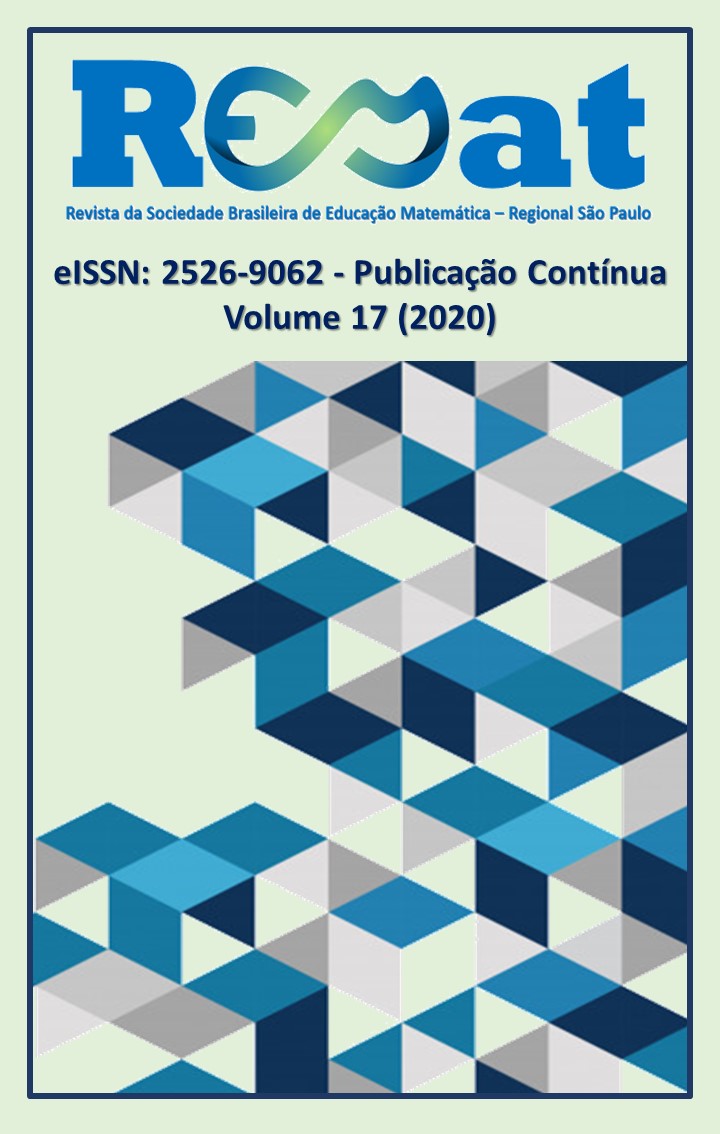Mathematics Teaching and Children's literature: a personalized proposal for the learning of 4th grade Elementary School students
DOI:
10.37001/remat25269062v17id402Keywords:
Teaching mathematics, Children’s literature, Elementary SchoolAbstract
This article aims to present a didactic-pedagogical proposal, organized to mediate the learning of mathematical knowledge objects using children's literature as a stimulating vector for the teaching-learning process related to numbers, problems involving the four operations, mass measures and the monetary system. The children's literature used was “The Problems of the Gorgonzola Family”. The research participants were 20 students from a 4th grade class in the early years of Elementary school, in a public school in the county of Ponta de Pedras / PA. The original research belongs to a project, entitled “Mathematical Challenges: the problems of the Gorgonzola family”, organized during the theme development, Thematic Internship II, in the Integrated Degree Course in Sciences, Mathematics and Languages aimed at training teachers to work in initial years of elementary school, first and second cycles, as well as on youth and adult education equivalent to that level. The research is qualitative based on ideas of Borba and Araújo. It was developed in two moments, the first being the presentation of the book to class for reading and exploring the information and the second was configured by challenges proposed to students in the form of problems from the reading performed. The works were developed in groups and presented to class and to researcher teacher. The data collection carried out on research to effectuate analyzes was done through records - photographic, audiovisual and notes on researcher's logbook - from the students' production during group interactions to propose solutions to the proposed problems. Among the results found there is evidence that the environment built by the teacher, offered opportunities for students to organize, explore, connect their thoughts, new knowledge and build multiple perspectives and meanings on the same subject in focus, in this case the mathematical knowledge related to numbers, problems involving the four operations, measures and monetary system, as well as it stimulated students to perform readings and interpret the proposed problems both individually and collectively, and through dialogue and interaction participated on their learning, mediated by knowledge offered by the children's literature.
Downloads
Metrics
References
ALARCÃO, I. Professores reflexivos em uma escola reflexiva. 5ª. Editora São Paulo: Cortez, 2011.
AZEREDO, M. A; REGO, R.G. Linguagens em Matemática: a importância dos diferentes. registros semióticos. Revista Temas em Educação, João Pessoa, v.25, número especial, p.157 – 172, 2016.
BAGNE, J; NACARATO, A, M. A prática do diálogo em sala de aula: uma condição para elaboração conceitual matemática dos alunos. Revista Reflexão em Ação, Santa Cruz do Sul, v.20, n2, pg.186 a 214, julho/dez. 2012.
BORBA, M.C; ARAUJO, J.L. Pesquisa Qualitativa em Educação Matemática. 3ª. ed. Belo Horizonte. Autêntica, 2010.
BOGDAN, R. C.; BIKLEN, S. K. (1994). Investigação Qualitativa em Educação. Tradução: Maria João Alvarez, Sara Bahia dos Santos e Telmo Mourinho de Baptista. Revisor: Antônio Branco Vasco. Portugal, Porto Editora.
BRASIL, PCN. Parâmetros Curriculares Nacional, 1997: Disponível em: https://educador.brasilescola.uol.com.br/orientacoes/pcnparametros-curriculares-nacionais.htm. Acesso em: 25/03/2019.
BRASIL, BNCC. Base Nacional Comum Curricular, 2017: Disponível em: http://portal.mec.gov.br.
CAVALCANTE, C.T. Diferentes formas de resolver problemas. In: SMOLE, K.S; DINIZ, M.I. (orgs). Ler e resolver problemas: habilidades básicas para aprender matemática. Editora S.A ARTMED, Porto Alegre,2001.
COSTA, S. FUNDAMENTOS E DIDÁTICA DA MATEMÁTICA II. 1ªed. -2007. Disponível em: http://www.ead.ftc.br/portal/upload/cns/5p/01FundamentoseDidaticadMatematicaII.pdf. Acesso em 10/03/19.
CHICA, C. H. Por que formular problemas. In: SMOLE, K.S; DINIZ, M.I. (orgs). Ler e resolver problemas: habilidades básicas para aprender matemática. Editora S.A ARTMED, Porto Alegre, 2001.
D’AMBRÒSIO, U. Educação Matemática: da teoria à prática. Campinas, SP: Papirus. 17ª edição, 2009.
FURNARI, E. Os Problemas da Família Gorgonzola. São Paulo: Moderna, 2015.
GALVÃO, E. D. S. Interagir, Comunicar, Refletir: ambiente de aprendizagem matemática numa perspectiva de resolução de problemas. Bragança Paulista, 2014, 191, Dissertação Mestrado- Universidade São Francisco.
LORENZATO, S. Para aprender matemática.3 ed. rev. Campinas, SP: Autores Associados, 2010. (Coleção Formação de Professores).
MACCARINI, J. M. Fundamentos e Metodologia do Ensino de Matemática. Curitiba: Editora Fael, 2010.
NACARATO, A. M. A escrita nas aulas de matemática: diversidade de registros e suas potencialidades. Leitura: Teoria & Prática, Campinas, v.31, n.61, p.63-79, nov. 2013a.
NACARATO, A.M; MENGALI, B.L. S; PASSOS, B.C.L. A matemática nos anos iniciais do Ensino fundamental: tecendo fios do ensinar e do aprender. Belo Horizonte. Editora Autêntica, 2009.
NACARATO, A. M. Práticas docentes em Educação Matemática: nos anos iniciais do ensino fundamental. 1. Editora Curitiba: Appris, 2013b.
PONTE, J. P.; BROCADO, J.; OLIVEIRA, H. Investigações Matemáticas na sala de aula. Editora Autêntica, Belo Horizonte, 2015.
STANCANELLI, R. Conhecendo os diferentes tipos de problema. In: SMOLE, K.S; DINIZ, M.I. (orgs). Ler e resolver problemas: habilidades básicas para aprender matemática. Editora S.A ARTMED, Porto Alegre, 2001.
SMOLE, K. C. S. et. al. Era uma vez na matemática: uma conexão com a literatura infantil. 6. ed. São Paulo, SP: (CAEM) Centro de Aperfeiçoamento do Ensino de Matemática: Instituto de Matemática e Estatística da USP, 2007.
Downloads
Published
Métricas
Visualizações do artigo: 439 PDF (Português (Brasil)) downloads: 162
How to Cite
Issue
Section
License

This work is licensed under a Creative Commons Attribution-NonCommercial-NoDerivatives 4.0 International License.


 Português (Brasil)
Português (Brasil)
 Español (España)
Español (España)
 English
English






































